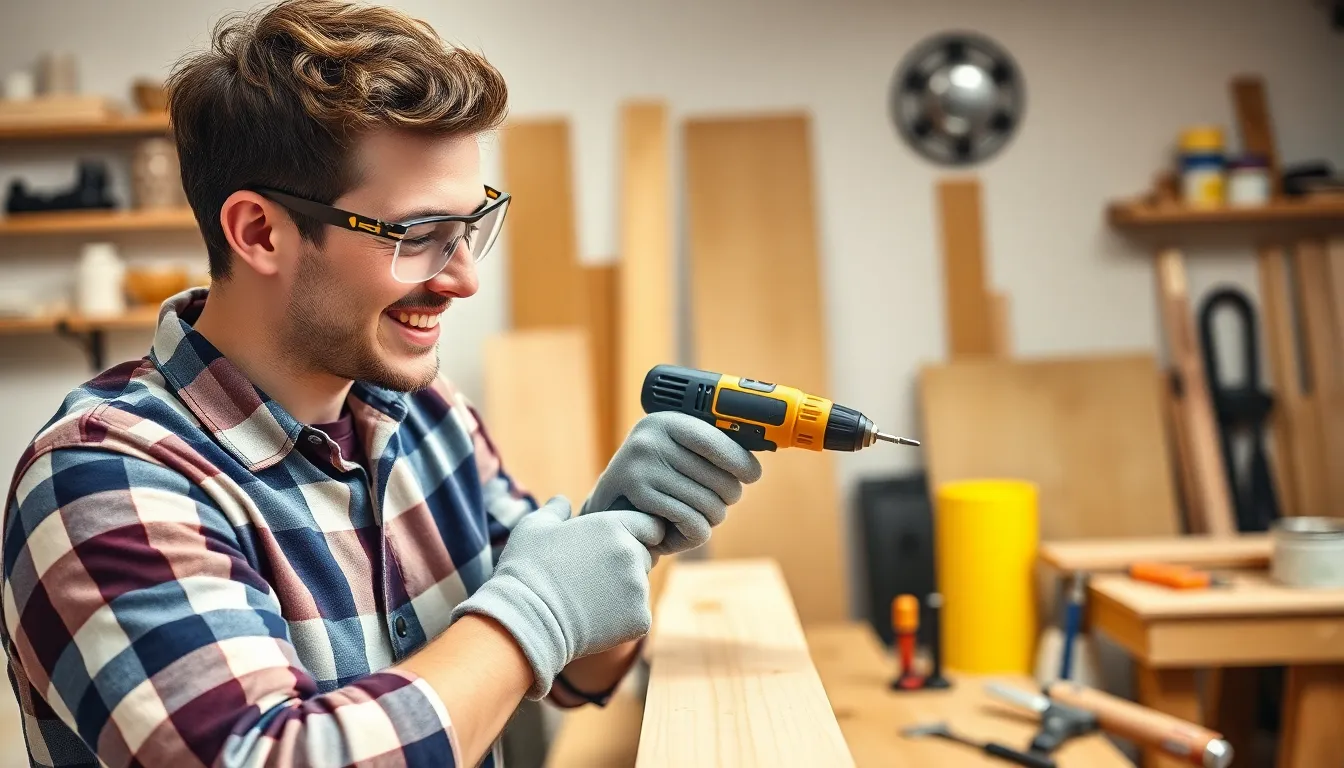Looking to unleash your inner DIY guru? Home improvement doesn’t have to be an intimidating adventure filled with power tools and Pinterest fails. With the right guidance, even the most novice of beginners can transform their living spaces into stylish havens.
Imagine turning that drab corner of your living room into a cozy reading nook or creating a stunning gallery wall that’ll have your friends asking for your secret. DIY home projects are not just about saving money; they’re a chance to flex creativity and add a personal touch to any space. So grab your tools and roll up those sleeves. It’s time to dive into a world where every project is a step toward making a home that truly reflects who you are.
Table of Contents
ToggleOverview of DIY Home Projects for Beginners
DIY home projects provide an accessible way for beginners to enhance their living spaces. Transforming a room can be simple and rewarding. Popular projects include creating a cozy reading nook, painting walls, and installing shelving. Beginners can tackle many tasks without prior experience.
Basic tools like screwdrivers, hammers, and levelers enable individuals to accomplish projects confidently. Furthermore, many online resources offer step-by-step tutorials, making learning straightforward.
Simple projects yield impressive results, such as refurnishing old furniture for a modern look. Personalizing spaces also fosters a creative outlet. Houseplants, wall art, and decorative accents can elevate any area to reflect individual style.
Budget-friendly options attract many beginners. Finding reclaimed wood or upcycled materials enhances creativity while saving money. Local thrift stores often hold hidden treasures, waiting for transformation.
Starting with small projects builds confidence. Beginners can try their hands at creating handmade coasters, or even customizing flowerpots. Completing a few successful projects encourages exploration of more advanced tasks.
Overall, embracing DIY projects offers newcomers an invaluable opportunity. They gain practical skills while adding personal touches to their homes. Taking the first step can lead to a fulfilling journey of home improvement. With a bit of research, dedication, and creativity, anyone can embark on this exciting adventure.
Essential Tools for DIY Projects

Having the right tools simplifies DIY home projects and increases success. Beginners can achieve great results with just a few essential items.
Must-Have Basic Tools
Basic tools provide the foundation for various DIY tasks. A hammer facilitates driving nails and assembling furniture. Screwdrivers come in different types, with Phillips and flathead being the most common. A tape measure ensures accurate measurements when cutting or spacing objects. Pliers assist in gripping, twisting, and bending materials. Additionally, a utility knife handles a variety of cutting tasks easily. Safety gear, such as goggles and gloves, protects users during projects. These essentials create a solid toolkit for anyone starting their DIY journey.
Optional Tools for Specialized Projects
Certain projects require additional tools to improve efficiency and results. A power drill allows for quicker drilling and screw fastening, making it invaluable for many tasks. An orbital sander smooths surfaces, ideal for refinishing furniture. Level tools help ensure items, such as shelves or frames, are perfectly aligned. Clamps secure materials while working, preventing movement for safer cuts. A stud finder detects wall studs, ensuring accurate placement for heavier items. These optional tools enhance capabilities, allowing for more complex and diverse DIY projects.
Simple DIY Home Projects
Beginners can easily dive into DIY projects that enhance their living spaces. Catching the eye with creativity or functionality is simple with these ideas.
Home Decor Ideas
Wall art can transform a space. Framing fabric or creating a custom painting adds a personal touch. Handmade pillows or cushions also bring color and comfort. Using fresh paint in bold shades creates an unexpected visual pop. Wall-mounted shelves provide both storage and display options, showcasing books and decor items beautifully. Repurposing old jars into flower vases introduces a rustic charm. These decor ideas allow individuals to personalize their surroundings while maintaining an inviting atmosphere.
Basic Furniture Projects
Building a simple bookshelf can improve organization and style. It requires minimal materials and can be customized to fit any room. A pallet coffee table brings a trendy, industrial feel at a low cost. Staining or painting existing furniture updates its look instantly. Customizing a dining table with stenciled designs can create a conversation starter. Adding new handles or knobs on dressers or cabinets enhances their appeal. These projects encourage creativity and result in functional pieces that elevate home aesthetics.
Safety Tips for DIY Projects
Safety is crucial in any DIY project. Following specific guidelines ensures a secure and enjoyable experience.
Proper Gear and Equipment
Using appropriate safety gear minimizes risks. Safety goggles protect eyes from debris while cutting or sanding. Wearing gloves prevents cuts and scrapes from sharp materials. Sturdy footwear, like closed-toe shoes, shields feet during heavy lifting. A dust mask keeps harmful particles from the lungs, especially when working with wood or paint. Keeping a first-aid kit nearby provides immediate assistance for minor injuries. It’s wise to use tools designed for the specific task, ensuring both safety and efficiency.
Safe Work Practices
Adopting safe work habits improves overall safety. Organizing the workspace eliminates tripping hazards from clutter. Ensuring proper ventilation when working with paints or solvents reduces exposure to toxic fumes. Always reading and following tool instructions enhances understanding of safe operation. Keeping children and pets away from the work area prevents accidents. Taking regular breaks helps maintain focus and prevents fatigue-related errors. Finally, double-checking that tools are in good condition prevents malfunctions, making the DIY process smoother and safer.
Resources for Learning DIY Techniques
Exploring DIY techniques has never been easier with various resources available. Beginner DIY enthusiasts can access a wealth of information online.
Online Tutorials and Videos
YouTube features countless DIY channels that provide step-by-step video tutorials. Websites like Home Repair Tutor and DIY Network offer detailed guides suited for novices. These visual resources help clarify complex projects and demonstrate techniques in real-time. Users can also find blogs with comprehensive articles and illustrations that cover everything from basic repairs to advanced decor ideas. Many platforms allow viewers to ask questions and engage with content creators, enhancing the learning process.
Community Workshops and Classes
Local hardware stores often host workshops that cover essential DIY skills. Classes range from basic woodworking to advanced home improvement projects. Community centers may also offer seminars where participants can learn hands-on techniques from experienced instructors. Networking with fellow DIYers can provide additional support, inspiring fresh ideas and collaboration. Many libraries also organize DIY events, creating opportunities to gain practical experience without any cost. Engaging in these classes promotes skill development while fostering a sense of community.
Embracing DIY home projects opens up a world of creativity and personal expression. Every small project completed adds to the overall charm of a living space while building confidence in one’s skills. With the right tools and safety measures in place anyone can tackle various tasks from painting to furniture building.
The wealth of resources available ensures that beginners can find guidance and inspiration easily. Whether it’s a cozy reading nook or a stylish gallery wall each project brings a sense of accomplishment. So why wait? It’s time to roll up those sleeves and start transforming a home into a true reflection of personal style.

